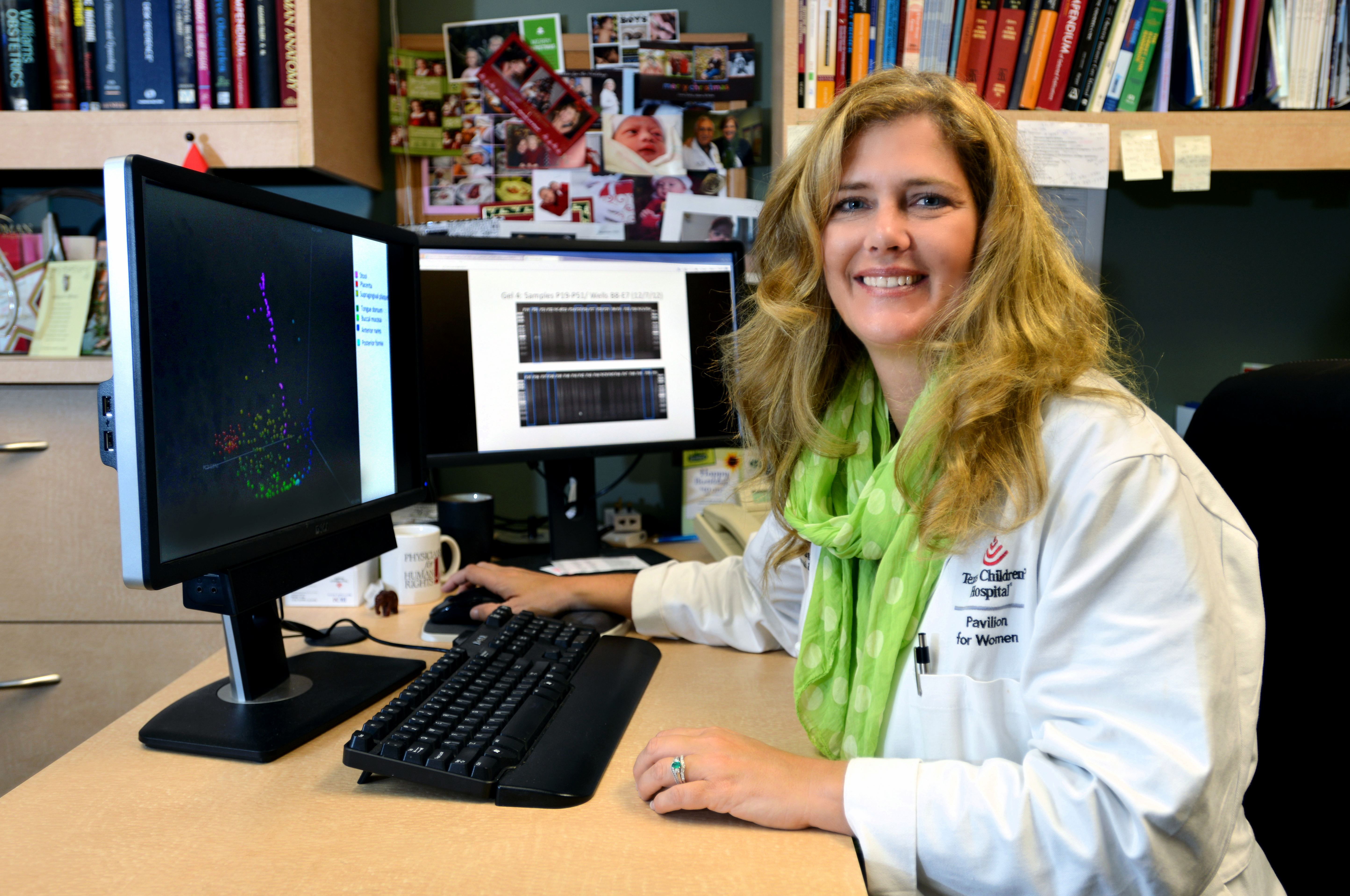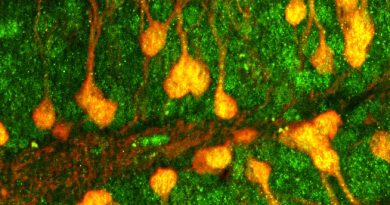Shedding light on the microbiome during pregnancy

We are not alone. With us at all times from conception on, is the microbiome – a collection of microbes made up of bacteria, viruses, single cell eukaryotes, and fungi that inhabit the human body. These are not disease-causing bacteria and viruses, instead they cohabitate with human cells and help cells properly function. Understanding how the microbiome communities develop is an important part of understanding how they relate to disease.
Dr. Kjersti Aagaard, associate professor of obstetrics and gynecology in the section of maternal fetal medicine at Baylor and the Texas Children’s Pavilion for Women, and her colleagues are key memebers in the collaborative National Institutes of Health funded Human Microbiome Project which seeks to further characterize these communities and how they relate to health and healing. Her team works in collaboration with the Alkek Center for Metagenomics and Microbiome Research (CMMR) at Baylor.
Two studies have recently shed light on how the microbiome found in different parts of the body function from the earliest stages of life. These findings could lead the way to further research looking at pre-term birth prevention and how a mother’s diet can affect her child’s health throughout life.
Diet – not obesity – defines a body’s microbiome communities
Consuming a high fat diet during pregnancy and breast feeding persistently alters the structure of an infant’s microbiome — the small organisms that live in and on our bodies that help cells carry out their function – said researchers from Baylor College of Medicine and Oregon Health & Science University in a new study that appeared today in the journal Nature Communications.
“We know the human microbiome plays a pivotal role in human health and disease,” said Dr. Kjersti Aagaard, lead investigator and corresponding author on the report and an associate professor of obstetrics and gynecology at Baylor. “It is critically important that we understand how the microbiome changes from one person to the next, and what drives those individual changes. Part of that process is looking at how the microbiome is established early on during infant development, and what impacts these earliest microbiome communities, that will bear an impact throughout the rest of their life.”
For several years, there have been reports linking the microbiome with obesity, but there are limitations in both humans and mice where “cause” versus “mere association” have yet to be teased apart, she said.
Aagaard and her colleagues at OHSU’s Oregon National Primate Research Center have focused for several years on the role a high fat maternal diet, rather than just obesity, plays on the health of the infant. They have shown that in the primate the diet is the primary driver which perturbs the developing infant’s epigenome (the molecules and chemical modifications that decorate the human genome after the basic pattern of genomic DNA is established.)
In the study using non-human primates, the team observed dams and their offspring (both lean and obese) exposed to a high fat diet, and compared them to control diet exposed animals for up to 1 year of age.
“This enabled us to differentiate the impact of maternal obesity versus high fat diet on the developing fetus,” said Aagaard. “We observed an interesting phenomenon, about 1/3 of the dams did not become obese despite many years of exposure to a high fat diet.”
Building on these findings, Aagaard and her colleagues now sought to distinguish whether it was the diet or obesity which appeared to drive changes in the dams and their offspring’s microbiome. They found that it was a high fat diet, rather than obesity, that defined the microbiome communities of the gut.
The finding is key, she said. “A woman can more easily alter her diet from high fat to low fat, but safely and realistically cannot change her obesity status in the short course of pregnancy.”
Additionally, the team observed that Campylobacter (bacteria attributed to diarrheal illness in humans) was eradicated in the offspring with either maternal or post-natal, high-fat diet.
“In humans, this group of bacteria causes diarrheal illnesses, but in primates many species are commensal (neutral, not disease causing),” said Aagaard. “This suggests that a bacteria being pathogenic or disease causing may not always be because it mutates or changes, but rather our dietary changes over time evolve our microbial community such that what was once harmless becomes harmful.”
Pregnancy and lactation may be crucial windows for establishing the earliest colonizers in our microbiome, she said.
More importantly, it suggests that the association between obesity and the microbiome is more affect than cause.
“Based on our well-grounded observations in primates, it appears that a high fat diet drives changes in the intestinal microbiome. This in turn is associated with obesity some—but not all—of the time,” said Aagaard. “In fact, even lean animals on a high fat diet were observed to have an altered microbiome. Importantly, being born and breastfed to a high fat diet fed mom persistently and significantly changes the offspring’s microbiome. This is true even when a healthy control diet is given after weaning.”
Other authors on this report include: Jun Ma, Amanda L. Prince, David Bader, Dr. Min Hu, Dr. Radhika Ganu, Dr. R. Alan Harris, all of Baylor; Karalee Baquero, Peter Blundell, Dr. Antonio E. Frias and Dr. Kevin L. Grove, all of the Oregon National Primate Research Center at Oregon Health & Science University in Beaverton.
Funding for this work was provided by the National Institutes of Health (P51 OD011092, DP21DP2OD001500, NR014792, R01DK079194 and R01DK089201).
Aagaard is also a physician at the Texas Children’s Pavilion for Women.
Landmark study reveals first genetic snapshots of unique placental microbiome
The placenta is not as sterile as once thought. New research shows that the placenta harbors a unique, low abundant microbiome, said researchers from Baylor College of Medicine and Texas Children’s Hospital.
The findings, in the current issue of the journal Science Translational Medicine, provide important new insights on the structure of the placental microbial community, the organisms present, and how they might be capable of impacting a pregnancy.
“After we completed our studies of the vaginal microbiome in pregnancy we noted that the most abundant microbes in the mom’s vagina were not what populated the baby’s intestinal microbiome,” said Dr. Kjersti Aagaard, associate professor of obstetrics and gynecology in the section of maternal fetal medicine at Baylor and the Texas Children’s Pavilion for Women, and the lead and corresponding author on the report. “We reasoned that there must be another source ‘seeding’ the infant’s gut at birth, so we sought to examine the placenta.”
The microbiome is the population of microbes – bacteria, viruses and fungi – that cohabit with human cells and help cells complete their tasks. Understanding what characterizes the microbiome communities is essential for understanding human development, Aagaard said.
In this study, the first and largest study to focus on the placental microbiome, 320 human subjects’ samples were analyzed comprehensively following a process called shotgun metagenomic sequencing. This technology enables microbiologists to uniquely evaluate bacterial diversity and detect the abundance of specific microbes and all their genetic pathways in a community.
The researchers showed that the placenta is not sterile (free from bacteria or other living organisms), but rather harbors a diverse and very unique microbiome.
“The placental microbiome is low in terms of microbial abundance but not as sterile as we previously thought,” said Aagaard.
Of the samples, Escherichia coli (E. coli) was the species with the highest abundance in most individuals, a bacteria that lives in the intestines of most healthy individuals. Prevotella tannerae (gingival crevices) and non-pathogenic Neisseria species (mucosal special surfaces), both species of the oral cavity, were also detected in highest relative abundance.
“Interestingly, when we looked very thoroughly at the placenta in relation to many other sites of the body, we found that the placental microbiome does not bear many similarities to microbiomes closest in terms of anatomic location. Specifically, it is not much like the vaginal or intestinal microbiome, but rather is most similar to the oral microbiome,” said Aagaard.
The finding has important implications on the likely importance of oral health during pregnancy, she said. “It reinforces long-standing data relating periodontal disease to risk of preterm birth.”
Additionally, the researchers observed differences in the placental microbiome based on a remote history of infection during the pregnancy (most commonly urinary tract infections from many months ago that were treated successfully with antibiotics).
The placental microbiome is also unique based on whether a preterm birth occurred, the researchers found.
“Exposure of the fetus to a placental microbiome may have fundamental implications for early human development and the physiology of pregnancy,” said Dr. James Versalovic, co-author on the report, professor of pathology at Baylor and head of pathology at Texas Children’s Hospital.
A larger study is currently underway to expand these findings to describe the placental and microbiome profiles across pregnancy and in relation with preterm birth.
“The hope is that we will get a clearer picture of how several of the microbial communities in women and their placentas change over the course of the entire pregnancy among those at risk for preterm birth. These discoveries could lead to rapid breakthroughs in not only identifying women at risk for preterm birth, but developing new and worthwhile strategies to prevent preterm birth,” said Aagaard. “As we catch glimmers of the microbial biology of pregnancy, we can start to see a not too distant future where we will prevent preterm birth (or its complications in newborns) with truly novel approaches aimed at enhancing the healthy microbes of not just the vagina, but the mouth and gut. As we unravel the mysteries of pregnancy, we are learning that our microbes may be as much friend as foe. That is fantastic news for our moms and their babies.”
Additional authors include Jun Ma, Dr. Kathleen M. Antony, Dr. Radhika Ganu and Dr. Joseph Petrosino all of Baylor.
Funding for this work was provided by the National Institutes of Health Director’s New Innovator Award (to Aagaard); the Burroughs Welcome Fund Preterm Birth Initiative (to Aagaard and Versalovic); the National Institutes of Health’s National Human Genome Research Institute as well as the Director’s Common Fund (to Aagaard, Versalovic, and Petrosino); and the Alkek Center of Metagenomics and
Microbiome Research (led by Petrosino with funding awards to Ganu and Aagaard).




I trace any information there, and I found this wonderful website, information about pregnancy that I can I will present to all women in Indonesia through my blog
the problem of obesity has become epidemic outbreaks, should be prevented from pregnancy
Dr. Kjersti Aagaard, very important study and well-written article. I agree with the result and conclusion of the study. Diet is responsible for baby’s microbiome communities.
A mother should be careful and should have the good food for the pregnancy and baby.
Dr Rajesh MD